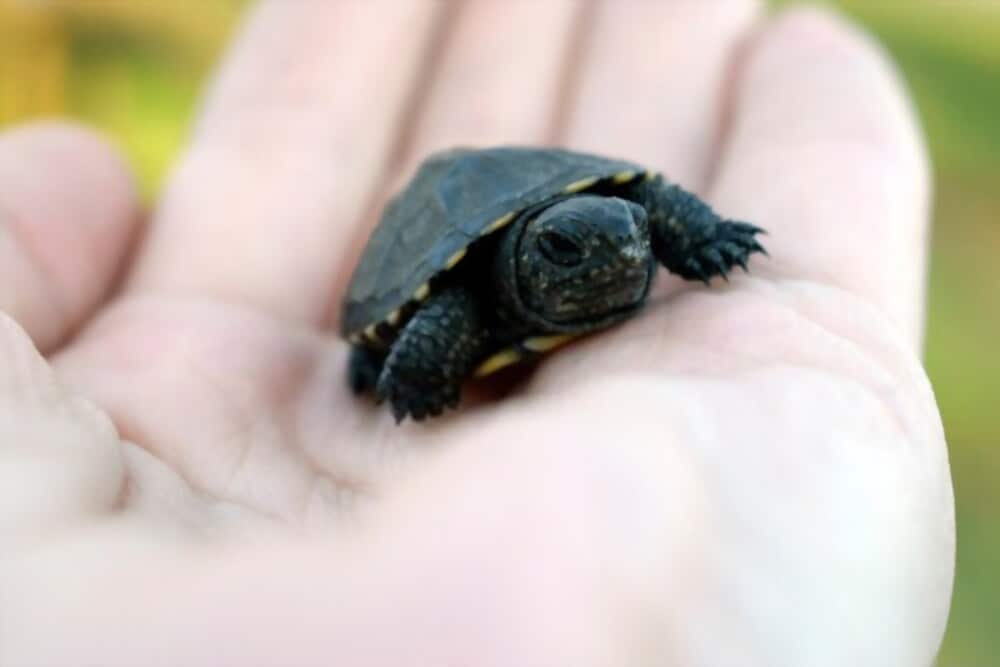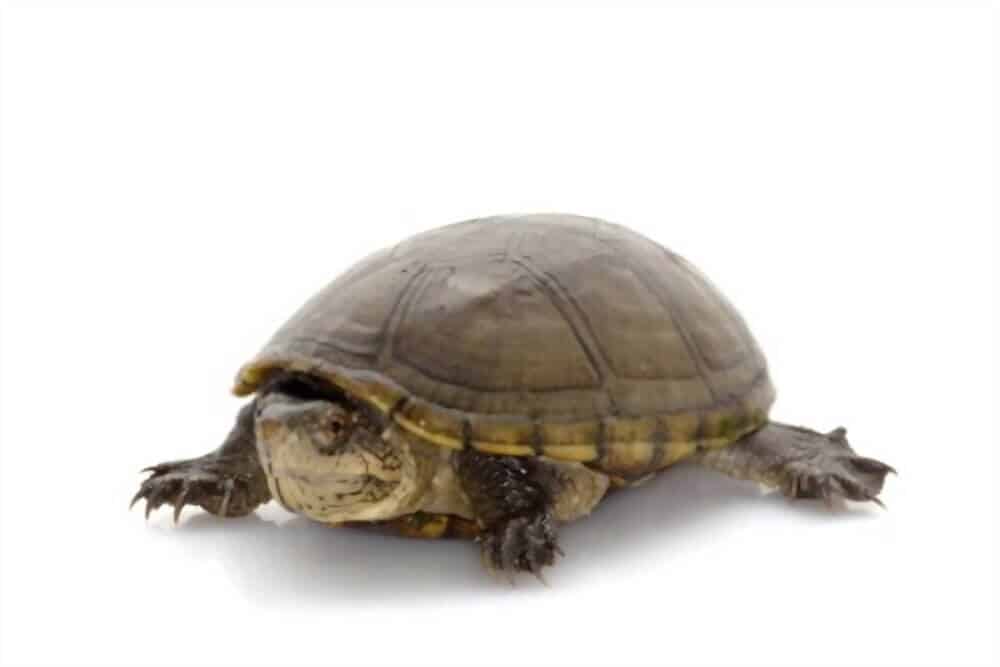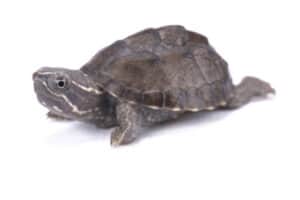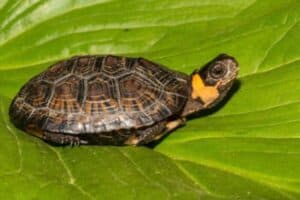You may have heard the old phrase, “good things come in small packages.” Small things or animals bring different vibes, like- we want to take care of them, feed them, and keep them safe. Smaller ones are adorable and fun to have.
Most of the pet owners wish if his or her pet remained small forever. You and I both know that’s not possible. As time passes, they grow bigger and larger.
But, if you have a pet that is a smaller breed and wouldn’t be much bigger as they reach their adulthood. That is great, right?
Well, turtles are usually small species, but some of them can grow bigger than your one-year-old kid. However, some species won’t grow about 5 inches only and no more than 10 inches.
If you are someone like me, who prefers a smaller pet. This article is for you. This article will introduce you to some of the most common and popular “small pet turtles that stay small”, even in their adult period.
Let’s get started-
1. Common Mud Turtle (Mostly 3-5 inches)
Mud Turtles are one of the smallest turtles which are kept as pets among hobbyists. They have two recognized subspecies; both are well known:
- Eastern Mud Turtle
- Mississippi Mud Turtle
They are from the family “Kinosternidae,” which includes around 25 species, and almost all of them are small. Mud turtle’s life span is about 30-50 years, and sometimes people do mistake them with Musk Turtle.
Body Description:
Though, there are no apparent discern features to mention about Mud turtles. However, their carapace is keelless, don’t have any specific pattern, and colors vary from yellowish to black. Mud turtle’s throats and chins are yellowish-grey, and their limbs and tails are a grayish color. Also, their feet are webbed.
Size:
The usual size for a mud turtle is around 3-6 inches (7.5-15 cm) in shell length. Male mud turtles are slightly larger than female ones.
The adult common mud turtles can reach the highest length of around 8 inches (20 cm) in the carapace. But it’s not usual.
Habitat:
Mud turtles are freshwater habitats; you can find them in lakes, swamps, rivers, and ponds. They prefer the area with lots of vegetation. They also like muddy or sandy areas, hence the name “Mud turtle.”
Diet:
This omnivorous reptile prefers fishes, worms, snails, and insects for their protein supply.
Aquarium Guide:
It’s not very easy or hard to have a Mud turtle as a pet; so, it’s better to have some experience.
UVB lighting is required with 25-40 gallons of water. And the water temperature should 75-80 °F; the basking temperature should be 90 °F.
Mud turtles do bite if they feel provoked. They wouldn’t be that aggressive unless you kept a number of them in a small space.
Are Mud turtles good pets?
Yes, Mud turtles are excellent as pets, and you can keep them inside (aquarium) or outside pond). They will do great in both places.
2. Musk Turtle (About 2 – 4.5 inches)
Another small turtle that stays small is “stinkpot.” Also Known as common musk turtle or eastern musk turtle. From the family “Kinosternidae,” Musk turtle has similarities with Mud turtle. So, you could mistake them for one another.
Musk turtle and stinkpot names were given because they emit a foul musky odor when they feel disturbed.
Musk turtle’s subspecies are:
- Loggerhead
- Razor-backed
- Common
- Flattened
Stinkpot lives around 30-50 years or more in captivity.
Body Description:
Small aquatic dark turtle with a plane, domed-looking shell, color varies from light olive-brown to almost black, or grey. It has a long neck and comparatively short legs. Male Musk turtles have slightly larger tail than the females.
The carapace (upper shell) is longer than the plastron (lower shell ). Their head’s sides have two distinct colored stripes. The lower shell has a single horizontal hinge towards the front and looks yellow or yellowish-brown color.
Size:
The usual length of a Musk turtle is around 2-4.5 inches (5-11.5 cm), but they have the potential to reach around 6 inches (15.25 cm) at their adult stage. Their average weight is about 603 g (1.329 lb.). Females are slightly larger than the male Musk Turtles.
Habitat:
Freshwater Musk turtles are highly aquatic and prefer to stay in heavily vegetated, shallow, and slow-moving creeks, rivers, ponds, or lakes. Females lay eggs on the land and a rather good climber.
To stay away from its predator, the Musk turtle release a strong musky odor from a small gland.
Diet:
Stinkpots are mostly carnivorous, but as they grow, they could eat plants or plant-based food too. Consume a wide variety of aquatic invertebrates like snails, aquatic larvae, freshwater clams, crayfish, small fish, tadpoles, carrion, and various insects.
Aquarium Guide:
Musk turtles are beginner-level pets; they are easy to care for and maintain.
UVB lighting is recommended if you are keeping them in a tank. You can have them both indoor or outdoor. 25-40 galloons are sufficient for stinkpot, as they don’t need much deep space.
Keep the water temperature between 70-80 °F. Busking isn’t a usual thing for a Musk turtle; still, it’s better to have a spot with around 90 °F.
Commercial foods, algae wafers, different insects and worms, crickets, etc. are good choices to feed them.
Are Musk Turtles Good Pet?
Actually, they are great pets. Easy to take care of and don’t need the expertise to have one. Also, you can put them inside or outside.
Do Musk Turtle Bite?
Yes, they do. And the bite is quite painful. However, if you handle them properly, there is no reason for them to bite you.
3. Spotted Turtle (About 3-4.5 inches)
If you create a list of the smallest turtles that remain small, the spotted turtle will be one of the tops of that list. The spotted turtle (Clemmys guattata) is the only species of Clemmys. It’s a small and semi-aquatic turtle.
They are commonly seen in the eastern US and southern Canada.
Body Description:
The spotted turtle is small and has a gray to black base color. They have distinct large yellow spots on the carapace, and its head, neck, and limbs are covered with orange-yellow markings. Baby spotted turtles may have a lack of spots on their carapace.
Their upper carapace is smooth and keelless. Spotted turtles have around 0-100 yellow spots on their body. The lower shell (plastron) is orange-yellow or yellow with noticeable black spots. Their tail has yellow stripping, not all of them, though.
And female spotted turtles have more spots than the males.
Size:
The usual size of spotted turtles are about 3-4.5 inches (7.5- 11.5 cm) long, but they could reach around 5 inches (12.7 cm). More than 5 inches isn’t a usual growth for spotted turtles.
Habitat:
Spotted turtles prefer shallow waters like marshes, flooded wooden forests, ponds, bogs, pools, stumps, and grass mats areas to live. They can sometimes change their home location but remain around 1-8 acres of space.
They commonly bask in groups in a place.
Diet:
Spotted turtles are aquatic omnivores. They are an active hunter and hunt at the temperature above 14.2 °C (57.6 °F). They consume exclusively in the water- plant material including aquatic vegetation, green algae, wild cranberries.
Animal food includes aquatic insect larvae, worms, slugs, millipedes, spiders, crustaceans, tadpoles, salamanders, and several genera of small fish.
Aquarium Guide:
Spotted turtles are good to keep in an aquarium. 20-35-gallon tanks are well suited for them. They prefer 50% water and 50% of land area.
The basking temperature is around 85-90 °F, and the water temperature should be around 75-85 °F. UVB light is always a good choice for a turtle tank.
Are Spotted Turtles Good Pets?
They are one of the smallest pet turtles and can live both indoor and outdoor. Spotted turtles are adorable and attractive pet. So, obviously, they are good pets. Though, some research showing that keeping them in captivity is putting this race into threats.
Do spotted turtles bite?
Yes, they do. But mostly in between themselves. So, don’t worry unless you make them irritated.
4. Bog Turtle (About 3-4 Inches)
The bog turtle (Glyptemys muhlenbergii) is the smallest turtle in the United States. They have been announced as critically endangered species. The search for bog turtle, collection, or selling is illegal.
They are highly attractive because of their size and weight, and they are pretty cute too. Bog turtles are semi-aquatic species and from the family Emydidae.
Body Description:
Bog turtles don’t have a prominent snout, and their head’s color is from dark brown to black. They have a red, orange, or bright yellow spot on each side of their neck. Bog turtle has a dark skin color with an orange-red wash on the inside of the legs, not all of them, though.
Their carapace is a kind of rectangular and domed shape. Bog turtles have similarities with painted and spotted turtles.
Size:
The usual size of an adult bog turtle is around 3-4 inches (7.1-10 cm). The largest bog turtle found in the US was 4.5 inches (11.5 cm). So, they don’t grow more than 5 inches, actually 4.5 inches.
The male bog turtles are slightly larger than the females.
Habitat:
The bog turtle is native to the eastern US. They form a colony with no more than 20 individuals. Bog turtles prefer wetlands (areas containing lime), including meadows, bogs, marshes, and spring seeps, that have both wet and dry regions.
Bog turtle’s habitat is also found on the edge of woods, cow pastures, and beaver dams.
Diet:
Omnivore Bog turtles eat aquatic plants, berries, seeds, snails, insects, slugs, earthworms, frogs, and other small vertebrates. They could also eat carrion. If you have one, you can feed them different vegetables, chicken hearts, and dog foods.
Aquarium Guide:
Though the law doesn’t encourage you to have a Bog turtle as your pet, they claimed, bog turtle doesn’t grow or breed under captivity. If you have one already, the water temperature should be around 65-75 °F with a basking spot between 85-90 °F.
UVB light helps keep them safe and sound. In the summer, provide more daylight than the winter.
You can feed a Bog turtle dragonflies, ants, millipedes, beetles, and other diets mentioned in their diet section.
5. Box Turtle (about 5-7 Inches)
Box turtles are apparently similar to the tortoise. They are North American and from the gun Terrapene. There are 6 subspecies with 12 taxa have been identified of Box turtles. They are one of the popular small turtles on our list that will stay small.
Box turtles are terrestrial and semiaquatic. They can draw their head and limbs entirely and look like a box; that’s where the name came. They live around 50-100 years or more.
Body Description:
Box turtles have a high and rounded carapace; the bottom shell is comparatively flattened. They have a transverse hinge and ligamentous connection between carapace and plastron. Their appearance and body shape are highly identical to a tortoise.
Size:
Box turtle’s average adult size is about 5-7 inches (12-17.5 cm) in carapace length. However, some of them could reach around 8 inches (20.3 cm).
Habitat:
Box turtles occupy a wide variety of habitats; so, it’s hard to mention specifically. They can be found on grassland and similar areas. Box turtle has one subspecies, “dessert box turtle,” which can be found in a semi-dessert area.
Before hibernation, they move to deep woods area to dig a chamber for winter preparation.
Diet:
Box turtles are omnivorous with a variety of diets. They will eat anything that they catch, like- earthworms, insects, millipedes. However, their diet consists of 30-90% vegetation, which is available to them.
Aquarium Guide:
Box turtles are easy to take care of. Commercial turtle foods are fine for them; obviously, you should mix them with other foods. UVB lighting is recommended, and the gallon size should be 20 or more.
The water temperature should be about 75 °F.
Are box turtles good pets?
If you can take care properly, Box turtles will be a great pet friend for you. They also live a long life; so, you don’t have to worry about losing them soon.
Do Box Turtle Bite?
Box turtle rarely hiss, snap or bite like other common pet turtles; So, it’s safe to let kid handle sometimes.
6. Reeve’s Turtle (around 6 Inches)
Mauremys reevesii, usually known as Chinese three-keeled pond turtle, Chinese pond turtle, or Reeve’s turtle is a part of the family Geoemydidae. They are native to Asia. However, Reeve’s turtles are a very popular pet turtle among hobbyists around the world.
Chinese pond turtle is one of the small turtles that remain small in their adulthood. This turtle is also farmed and consumed in China widely.
Reeve’s turtle was named in honor of English naturalist John Reeves.
They are sort of territorial; so, you need to be careful to have multiple in a small space.
Body Description:
Reeve’s turtle’s shell is quite rectangular and has three keels from back to the front. The carapace is normally dark, olive green, and black. The bottom shell usually cream-colored or tan. Other than these, there are not many features that are noticeable easily.
Size:
Chinese pond turtles are usually about 6 inches (15.2 cm) long during their adulthood. However, some large species could reach about 9 inches (22.8 cm) in carapace length.
Habitat:
Chinese pond turtles can be found in eastern and central China, North Korea, South Korea, Japan, and Taiwan.
They prefer still or slow-moving water like- ponds, small streams, lakes, and rivers with plenty of aquatic plants and soft substrate with basking areas.
Diet:
Reeve’s turtle isn’t picky eaters. They are omnivorous; they will eat from aquatic plants to insects, earthworms, snails, etc.
Aquarium guide:
50 gallons should be a good starting point for Chinese pond turtles; as you add more in that tank, add additional 15-20 gallons for every one of them.
Water temperature should be around 70-80 °F; the basking area temperature is around 85-95 °F is recommended, and the relaxing temperature should be about 75-85 °F.
You can feed them turtle commercial foods with different vegetables and small live foods.
Are Reeve’s Turtles Good Pet?
It has a friendly personality, which makes it an excellent pet to have. But you shouldn’t keep handling too much.
Do Reeve’s Turtles Bite?
Though they aren’t considered aggressive, they do bite if you handle them improperly. Also, they could get into a fight with each other about territory.
A Comparison Table of “Small Turtles that Stay Small”:
| Name | Mud Turtle | Musk Turtle | Spotted Turtle | Bog Turtle | Box Turtle | Reeve’s Turtle |
| Usual Size (Inches) | 3-6 | 2-4.5 | 3.45 | 3-4 | 5-7 | 6 |
| Highest Size(Inches) | 8 | 6 | 5 | 4.5 | 8 | 9 |
| Habitat | Freshwater | Freshwater | Freshwater | Freshwater | Freshwater & land | Freshwater |
| Experience Level | Intermediate | Beginner | Beginner-Intermediate | Intermediate | Beginner | Beginner |
| Life Span (Years) | 30-50 | 30-50 | 25-50 | Around 40 | 50-100 | 20 |
| Diet | Omnivore | Mostly Carnivore | Omnivore | Omnivore | Omnivore, but prefer plant materials | Omnivore |
| Tank Size (Gallons) | 25-40 | 25-40 | 25-35 | 3*2 Feet Tank | 20+ | 50 |
| Water Temperature | 70-80 °F | 70-80 °F | 75-85 °F | 65-75 °F | 75 °F | 70-80 °F |
| Basking Temperature | 90 °F | 90 °F | 85-90 °F | 85-90 °F | Don’t need much (80 ° F) | 85-95 °F |







